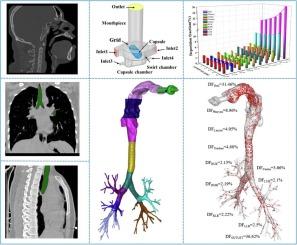关于吸入药物颗粒在现实吸入器-气道模型各区域沉积分布和机制的数值研究
IF 4.6
2区 工程技术
Q2 ENGINEERING, CHEMICAL
引用次数: 0
摘要
吸入给药被广泛应用于呼吸系统疾病的治疗。了解干粉吸入器(DPI)在气道不同区域的沉积机制对于吸入器的开发和药物颗粒沉积分布的预测至关重要。而且吸入器的插入会显著改变气道中的气流模式。本研究的主要目的是系统研究气溶胶颗粒在吸入器-气道模型各区域的沉积分布和机制。研究采用计算流体动力学(CFD)模拟吸入流速对药物颗粒在气道各区域沉积的影响。采用离散相模型(DPM)来跟踪药物颗粒的沉积轨迹。分析了三种不同的吸入流速、六种颗粒大小和五种颗粒密度。结果表明,药物颗粒的总体沉积分数随着颗粒大小和密度的增加而逐渐增加。除口腔外,其他局部区域的沉积分布模式与整体模式截然不同。咽部的沉积分数远大于其他局部区域,喉部、气管、心窝和支气管的沉积分数小于 5%。当吸入流速为 30 升/分钟时,密度的增加会提高颗粒在整个呼吸道各区域的沉积分数。口腔中的颗粒物大多沉积在舌头上,支气管中的颗粒物多分布在主干,而在支气管的深部,颗粒物也沉积在分叉区。受试者的吸气姿势也会影响气流的局部分布。本研究的结果有助于指导 DPIs 的优化和体内体外相关性研究。本文章由计算机程序翻译,如有差异,请以英文原文为准。

Numerical study on the deposition distribution and mechanism of inhaled drug particles in various regions of the realistic inhaler-airway model
Inhaled drug delivery is widely used in the treatment of respiratory diseases. Understanding the deposition mechanisms of dry powder inhalers (DPIs) in different regions of the airway is crucial for inhaler development and prediction of the deposition distribution of drug particles. And the insertion of the inhaler will significantly alter the pattern of airflow in the airway. The main objective of this study is to systematically investigate the distribution and mechanism of aerosol particle deposition in various regions of the inhaler-airway model. Computational fluid dynamics (CFD) was used to simulate the effect of inhalation flow rate on the deposition of drug particles in various regions of the airway. The discrete phase model (DPM) was adopted to track the deposition trajectories of drug particles. Three different inhalation flow rates together with six particle sizes and five particle densities were analyzed. The results indicated that the overall deposition fraction of drug particles gradually increased with particle size and density. The pattern of depositional distribution in other local areas is quite different from the overall pattern except in the oral. The deposition fraction in the pharynx was much larger than in the other local regions, the deposition fractions in the larynx, trachea, carina and bronchi were less than 5 %. The increase in density increases the deposition fraction of particles in various regions throughout the respiratory tract when the inhalation flow rate is 30 L/min. Most of the particles in the oral are deposited on the tongue, and the particles in the bronchus are more distributed in the main trunk, while deeper in the bronchus, particles are also deposited in the bifurcation region. The subject's inhalation posture also affects the local distribution of the airflow. The findings of present study can help to guide the optimization and in vitro-in vivo correlation of DPIs.
求助全文
通过发布文献求助,成功后即可免费获取论文全文。
去求助
来源期刊

Powder Technology
工程技术-工程:化工
CiteScore
9.90
自引率
15.40%
发文量
1047
审稿时长
46 days
期刊介绍:
Powder Technology is an International Journal on the Science and Technology of Wet and Dry Particulate Systems. Powder Technology publishes papers on all aspects of the formation of particles and their characterisation and on the study of systems containing particulate solids. No limitation is imposed on the size of the particles, which may range from nanometre scale, as in pigments or aerosols, to that of mined or quarried materials. The following list of topics is not intended to be comprehensive, but rather to indicate typical subjects which fall within the scope of the journal's interests:
Formation and synthesis of particles by precipitation and other methods.
Modification of particles by agglomeration, coating, comminution and attrition.
Characterisation of the size, shape, surface area, pore structure and strength of particles and agglomerates (including the origins and effects of inter particle forces).
Packing, failure, flow and permeability of assemblies of particles.
Particle-particle interactions and suspension rheology.
Handling and processing operations such as slurry flow, fluidization, pneumatic conveying.
Interactions between particles and their environment, including delivery of particulate products to the body.
Applications of particle technology in production of pharmaceuticals, chemicals, foods, pigments, structural, and functional materials and in environmental and energy related matters.
For materials-oriented contributions we are looking for articles revealing the effect of particle/powder characteristics (size, morphology and composition, in that order) on material performance or functionality and, ideally, comparison to any industrial standard.
 求助内容:
求助内容: 应助结果提醒方式:
应助结果提醒方式:


